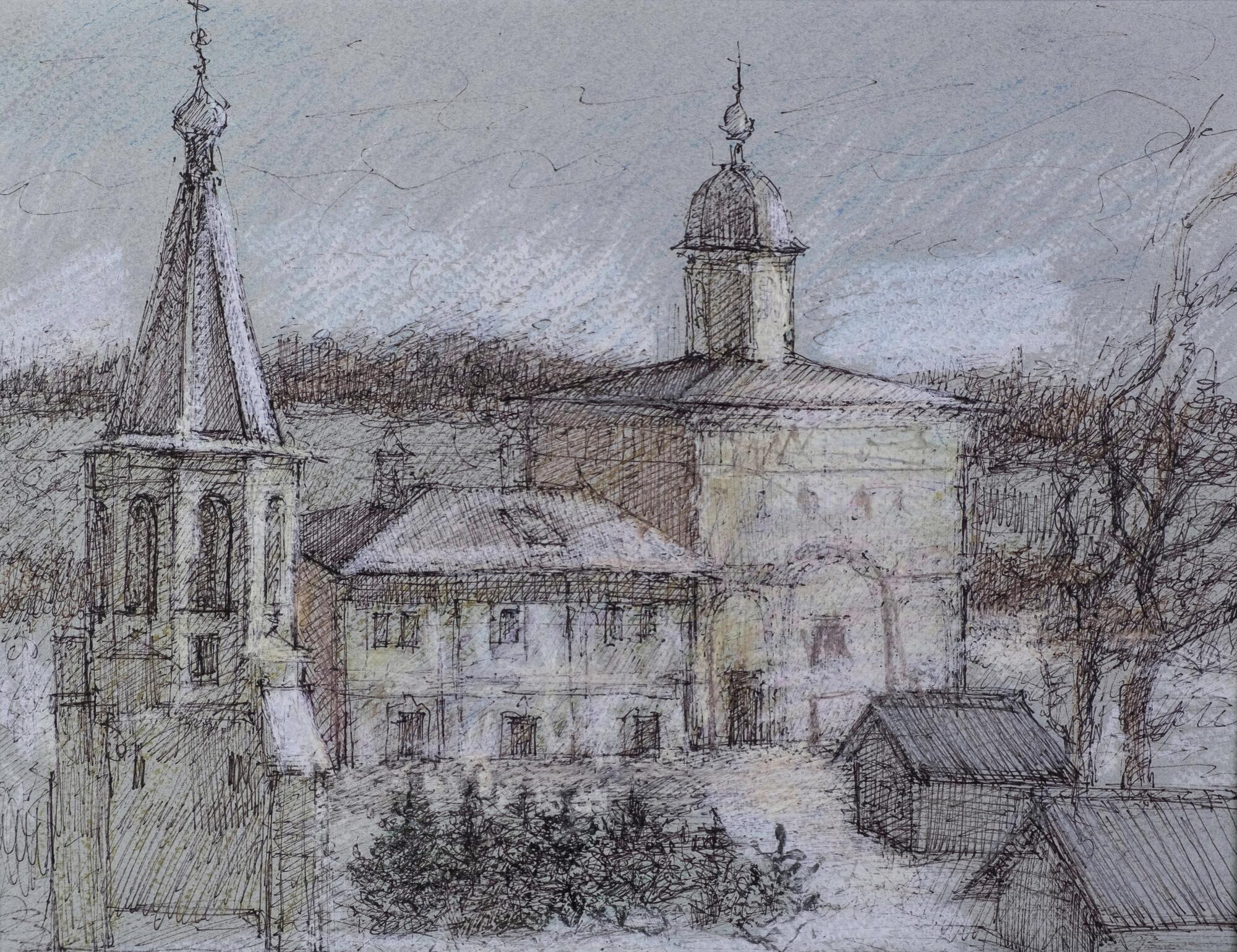The life and work of Elena Anatolyevna Vasilyeva are connected with Veliky Novgorod. There, she was born, studied at the Sergei Rachmaninoff College of Arts, and then at the Yaroslav-the-Wise State University. She established herself as an artist in Novgorod.
Vasilyeva creates oil, gouache, watercolor, and pastel paintings, as well as pencil drawings; among them — portraits, landscapes, genre scenes and still lifes. The artist teaches drawing and painting, actively participates in various exhibitions, and is a member of the Artists’ Union of Russia.
This painting shows a panorama of the now defunct Kolmovo Monastery, on the left bank of the Volkhov River.
The first stone church in honor of the Most Pure Theotokos was built on the territory of the monastery in 1423. Valentin Lavrentievich Yanin believes Nastasya Mikhailova to be its founder. She was the widow of Mikhail Yuryevich, the son of boyar Yury Ontsiforovich, who had founded the monastery.
The Assumption Church, which has been preserved, was built and re-consecrated under Archbishop Makarii of Novgorod in 1527–1528.
In 1685, it was rebuilt by the master Averky Mokeyev, who also added the Church of the Ascension.
The style of the building is characteristic of the church architecture of the pre-Mongol period.
The heyday of the monastery occurred during the reign of Metropolitan Job (from June 5, 1697 to February 3, 1716). The metropolitan first established a house for illegitimate and orphaned children at his own expense; over time, members of the imperial family and nobility began to donate money, as well as clothes and food. In addition, a hospital was opened at the monastery, and later an asylum for the mentally ill.
In 1866, it was decided to build a new stone building for patients with all amenities, including fresh water, as well as to equip areas for household activities.
In 1891, a school was opened at the church, where 32 pupils — boys and girls — were taught to read and write. The reader of the Assumption Church, Semyon Pavlovich Medvedsky, noticed that children could not read prayers, and opened the school at his own expense.
In 1917, an infirmary for the military was established at the Kolmovo Church.
In 1976–1997, under the supervision of Ninel Nikolayevna Kuzmina, the church was restored, and in 1998 it was consecrated.
Today, as before, services are held in it.
Vasilyeva creates oil, gouache, watercolor, and pastel paintings, as well as pencil drawings; among them — portraits, landscapes, genre scenes and still lifes. The artist teaches drawing and painting, actively participates in various exhibitions, and is a member of the Artists’ Union of Russia.
This painting shows a panorama of the now defunct Kolmovo Monastery, on the left bank of the Volkhov River.
The first stone church in honor of the Most Pure Theotokos was built on the territory of the monastery in 1423. Valentin Lavrentievich Yanin believes Nastasya Mikhailova to be its founder. She was the widow of Mikhail Yuryevich, the son of boyar Yury Ontsiforovich, who had founded the monastery.
The Assumption Church, which has been preserved, was built and re-consecrated under Archbishop Makarii of Novgorod in 1527–1528.
In 1685, it was rebuilt by the master Averky Mokeyev, who also added the Church of the Ascension.
The style of the building is characteristic of the church architecture of the pre-Mongol period.
The heyday of the monastery occurred during the reign of Metropolitan Job (from June 5, 1697 to February 3, 1716). The metropolitan first established a house for illegitimate and orphaned children at his own expense; over time, members of the imperial family and nobility began to donate money, as well as clothes and food. In addition, a hospital was opened at the monastery, and later an asylum for the mentally ill.
In 1866, it was decided to build a new stone building for patients with all amenities, including fresh water, as well as to equip areas for household activities.
In 1891, a school was opened at the church, where 32 pupils — boys and girls — were taught to read and write. The reader of the Assumption Church, Semyon Pavlovich Medvedsky, noticed that children could not read prayers, and opened the school at his own expense.
In 1917, an infirmary for the military was established at the Kolmovo Church.
In 1976–1997, under the supervision of Ninel Nikolayevna Kuzmina, the church was restored, and in 1998 it was consecrated.
Today, as before, services are held in it.


